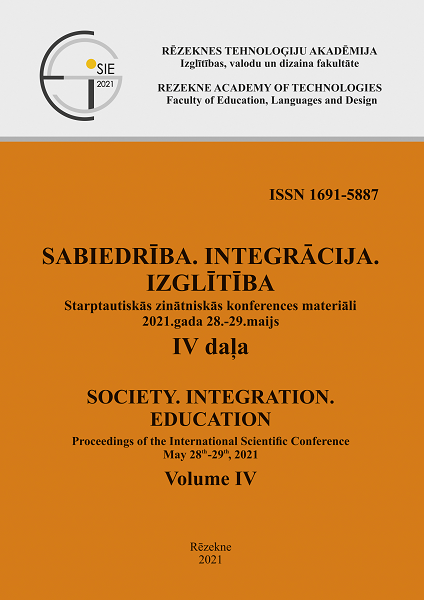GENERATIVE CREATING OF SACRAL SPACE: MYTHOLOGY, COSMOLOGY AND PLACES FOR CULT RITUALS
DOI:
https://doi.org/10.17770/sie2021vol4.6201Keywords:
evolution, generative creating, Latvian mythology, Latvian wisdom, red white Lielvārde belt, sacral space, system of geometrical signsAbstract
Signs are an integral part of the existence of humanity. The Latvians have one of the most complicated symbolic sign system in the world—the Lielvārde belt which includes symbols of strong energy and encodes ancient information that characterizes the special relation to nature and the Universe. God is the basis of moral values and the origin of all events. The understanding of Latvian deities is based on creative thought, and each sign of the deity image is a structural whole with a certain informative value. The Balts’ tribes for cult rituals chose energetically powerful places. Generative creating of sacral space and religious ritual is connected by concepts the Place, the Way and the Symbol. Research object: Latvian wisdom and spiritual traditions, sacral space for the worship of God. Research goal: analysis of the influence of the Latvian wisdom on traditions of the establishment of early places of worship. Research problem: common and different features of the sacral space of the Latvians and other nations have been little studied. Research novelty: detailed studies of generative creating of early places of worship based on Latvian mythology and cult ritual traditions of other nations. Research methods: analysis of archive documents and cartographic materials, study of published literature and inspection of sacral places in nature.
Downloads
References
Adamchik, M. V. (2005). Arhitektura. Kratkij spravochnik. Moskva, Minsk: AST, Harvest.
Apals, J. (1986). Arheoloģiskie pieminekļi Gaujas Nacionālajā parkā. Rīga: Zinātne.
Apals, J. (1996). Senie mājokļi Latvijā. No vissenākajiem laikiem līdz 13. gs. Rīga: RAKA.
Celms, V. (2016). Baltu dievestības pamati = Baltų religijos pagrindai. Rīga: Lauku Avīze.
Colabella, E. (2017). Generative art language. In XX Generative Art Conference Proceedings. Milan: Domus Argenia Publisher, 125–139.
Hubner, F., R. von (1899). Map of Byzantine Constantinople. London: Walker&Bontall sc.
Jordan, H. (1886). Map of ancient Rome City. In Professor G. Droysens Allgemeiner historischer Handatlas in sechsundneunzig Karten, mit erläuterndem Text. Bielefeld, Leipzig: Velhagen & Klasing.
Lanciani, R. (1893–1901). Roma. Plan of Papal Basilica of Saint Peter instead of the Circus of Nero. In Rodolfo Amedeo Lanciani, Luigi Salomone, Ulrico Hoepli, Accademia nazionale dei Lincei. (1893–1901). Forma Urbis Romae. Mediolani: Apud Ulricum Hoepli.
Le Roy, J., D. (1770). Les ruines des plus beaux monuments de la Grece, considérées du côté de l'histoire et du côté de l'architecture. Vol. Ι. Paris: Louis-François Delatour.
Ozola, S. (2017). Ethnographic symbols in Latvian regional architecture. In XX Generative Art Conference Proceedings, Milan: Domus Argenia Publisher, 353–394.
Reeves, N. (2017). Origin point: harmonic echoes of mineral cosmology (Mende Cathedral). In XX Generative Art Conference Proceedings, Milan: Domus Argenia Publisher, 288–319.
Soddu, C. (2016). The discovering persistent deep memory in generative design. In XIX Generative Art Conference Proceedings, Milan: Domus Argenia Publisher, 15–35.


